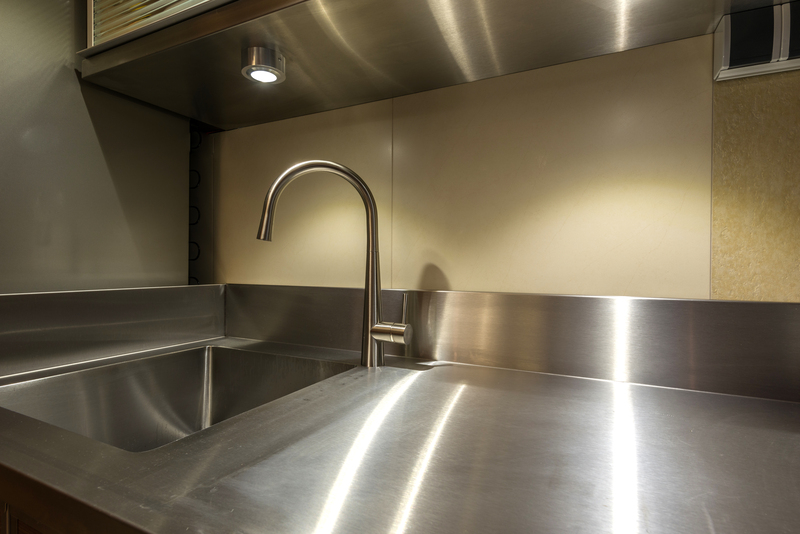Transform your window sills by removing mould effectively
Posted on 15/09/2025
Transform Your Window Sills by Removing Mould Effectively: A Comprehensive Guide
Window sills are often overlooked in home maintenance, yet they are crucial architectural elements that play a key role in the beauty, comfort, and structural integrity of your home. Over time, window sills can become breeding grounds for unsightly and potentially dangerous mould--especially in rooms with high humidity, like bathrooms and kitchens. If you've noticed black, green, or white spots creeping across your sills, don't panic! This comprehensive guide will teach you how to get rid of mould on your window sills effectively, prevent it from returning, and even enhance the overall look of your home.

Understanding Mould on Window Sills: Why Does it Form?
Before discussing the best techniques to eradicate mould from your window sills, it's important to understand why mould forms in these parts of your home in the first place.
- Moisture: Mould thrives in damp conditions. Poor ventilation, condensation from windows, and leaks can all create perfect growing conditions.
- Lack of sunlight: Shaded or north-facing windows generally receive less sunlight, allowing moisture to linger and create an environment conducive to mould growth.
- Organic material: Dust and dirt that accumulate on window sills can serve as a food source for mould spores.
- Poor insulation: Ill-fitting windows may let rain or condensation build up, particularly in colder climates.
If you're facing recurring mould issues on your window sills, addressing the underlying causes is as important as cleaning the mould itself.
Why is Mould on Window Sills Bad?
- Health risks: Inhalation of mould spores can trigger allergies or aggravate asthma symptoms.
- Structural damage: Prolonged mould exposure can disintegrate both wooden and painted surfaces.
- Aesthetics: Mould stains are unsightly and can lower the value and appeal of your space.
Step-by-Step Guide: How to Remove Mould from Window Sills
Ready to transform window sills by removing mould effectively? Follow these practical steps for safe and thorough mould removal.
What You'll Need
- Protective gloves
- Mask (N95 preferred)
- Safety goggles
- Protective covering for floors and nearby furniture
- Old toothbrush or small scrubbing brush
- Microfiber cloths
- Spray bottle
- White vinegar or hydrogen peroxide
- Baking soda (optional)
- Soap and water (for cleaning post-treatment)
Preparation: Safety Comes First
Always prioritize safety when dealing with mould! Open the windows in the area to maximize ventilation. Put on protective gloves, a mask, and goggles to avoid respiratory issues and skin injuries.
1. Identify and Assess the Mould
Not all mould infestations are created equal. In most cases, small patches (less than a square meter) can be handled DIY. If you notice extensive growth or suspect toxic black mould (Stachybotrys), consult a professional immediately.
2. Remove Surface Debris and Dust
- Use a dry cloth or vacuum (with HEPA filter) to carefully remove dust, dirt, and loose mould spores from the window sill surface.
- Avoid sweeping, which can disperse spores into the air.
3. Choose the Right Mould Remover
For most window sill mould removal, gentle and non-toxic cleaners work well:
- White Vinegar: Undiluted, vinegar is highly effective. Pour it into a spray bottle and apply generously to the affected area.
- Hydrogen Peroxide (3%): Also effective for killing mould. Apply with a spray bottle.
- Baking Soda: Mix with water to create a paste for scrubbing stubborn spots.
- Commercial Mould Removers: Available at hardware stores, though often contain harsher chemicals. Always follow manufacturer's instructions.
4. Clean and Scrub
- Spray your chosen solution on the mould and let it sit for at least 10-15 minutes.
- Using an old toothbrush or small scrubbing brush, gently scrub the surface until all visible mould is removed.
- If stains persist, reapply and wait longer before scrubbing again.
5. Rinse and Dry
- Wipe down the area with a clean, damp microfiber cloth.
- Use soap and water to clear any remaining traces of the cleaning agent.
- Dry thoroughly with a towel or a hair dryer on a cool setting. Moisture left behind can encourage mould regrowth.
6. Disinfect (Optional)
If you want extra protection, you can apply a disinfectant after cleaning, especially if you're dealing with recurring growth. Make sure to check product compatibility with your sill material.
Preventing Mould on Window Sills: Practical Tips
Prevention is key for maintaining mould-free window sills. Here's how you can stop the issue before it starts:
- Ventilation: Ensure windows can open; use fans or dehumidifiers in humid areas.
- Monitor and reduce humidity: Keep indoor humidity below 60% with the help of dehumidifiers or air conditioners.
- Wipe condensation: Regularly wipe off water accumulation on window glass and sills, especially in winter.
- Remove plant pots: If you keep plants on the sill, make sure their drainage water doesn't sit on the surface.
- Repair leaks: Fix faulty window seals and inspect where rainwater may intrude.
- Regular cleaning: Dust and wipe sills weekly to prevent organic matter accumulation.
- Use mould-resistant paint: When repainting, choose formulations that inhibit mould growth.
How to Deal with Persistent or Recurring Mould
If you've followed all the recommended steps and mould keeps returning to your window sills, it likely points to more serious underlying problems:
- Poor insulation or double glazing failure
- Hidden leaks in the wall or around the window frame
- Consistently high humidity or inadequate ventilation
*In such cases, consult a professional to assess and repair these issues.*
Restoring and Beautifying Window Sills After Mould Removal
Once you've successfully removed mould from your window sills, you have an excellent chance to transform their appearance for a fresh new look. Consider these restorative steps:
- Sand and repaint: Lightly sand the surface and apply mould-resistant primer and paint.
- Seal gaps or cracks: Use caulk to fill in areas where moisture might seep in.
- Decorate thoughtfully: Add plants, ornaments, or decorative trays--ensuring proper drainage and ventilation.
Bring More Light and Freshness
- Install sheer curtains: They allow sunlight to reach your sills, helping keep the area dry and mould-resistant.
- Display moisture-absorbing materials: Charcoal bags or silica gel containers can help regulate nearby humidity.
FAQs on Removing and Preventing Mould on Window Sills
Can I use bleach to remove mould?
While bleach can kill surface mould spores, it is not always recommended, especially on porous surfaces like wood. Bleach may simply whiten the surface, with mould regrowing shortly afterwards. Vinegar or hydrogen peroxide are better options.
Is mould on window sills dangerous?
Some types of mould are hazardous to human health, especially for those with allergies or respiratory conditions. If you or your family experience symptoms, or if the mould area is extensive, seek professional help.
Can I prevent mould on wooden window sills?
Yes! After cleaning, seal wood with varnish or mould-resistant paint, keep the area dry, and ensure good ventilation.
How often should I check my window sills for mould?
Inspect your window sills seasonally, especially after wet weather or in high-humidity months.

The Importance of Regular Maintenance for a Mould-Free Home
Having clear, sparkling window sills improves the overall ambience of your home and protects your family's health. Mould can creep up on even the most vigilant homeowners, but by:
- Recognizing the signs of mould early,
- Taking prompt, effective action to remove it,
- And adopting preventative habits
--you can keep your window sills clean, safe, and beautiful all year round.
Conclusion: Breathe New Life Into Your Window Sills by Removing Mould Effectively
Now you have a complete roadmap to transform your window sills by removing mould effectively. By following the step-by-step removal strategies and adopting preventative care, you'll not only eliminate unsightly stains but also create a healthier, more inviting home environment. With a little time and elbow grease, even the most neglected window sill can be restored to its former glory. Don't let mould overrun your space--act today, transform your sills, and enjoy the beauty and comfort of a mould-free home!
Related reading:




